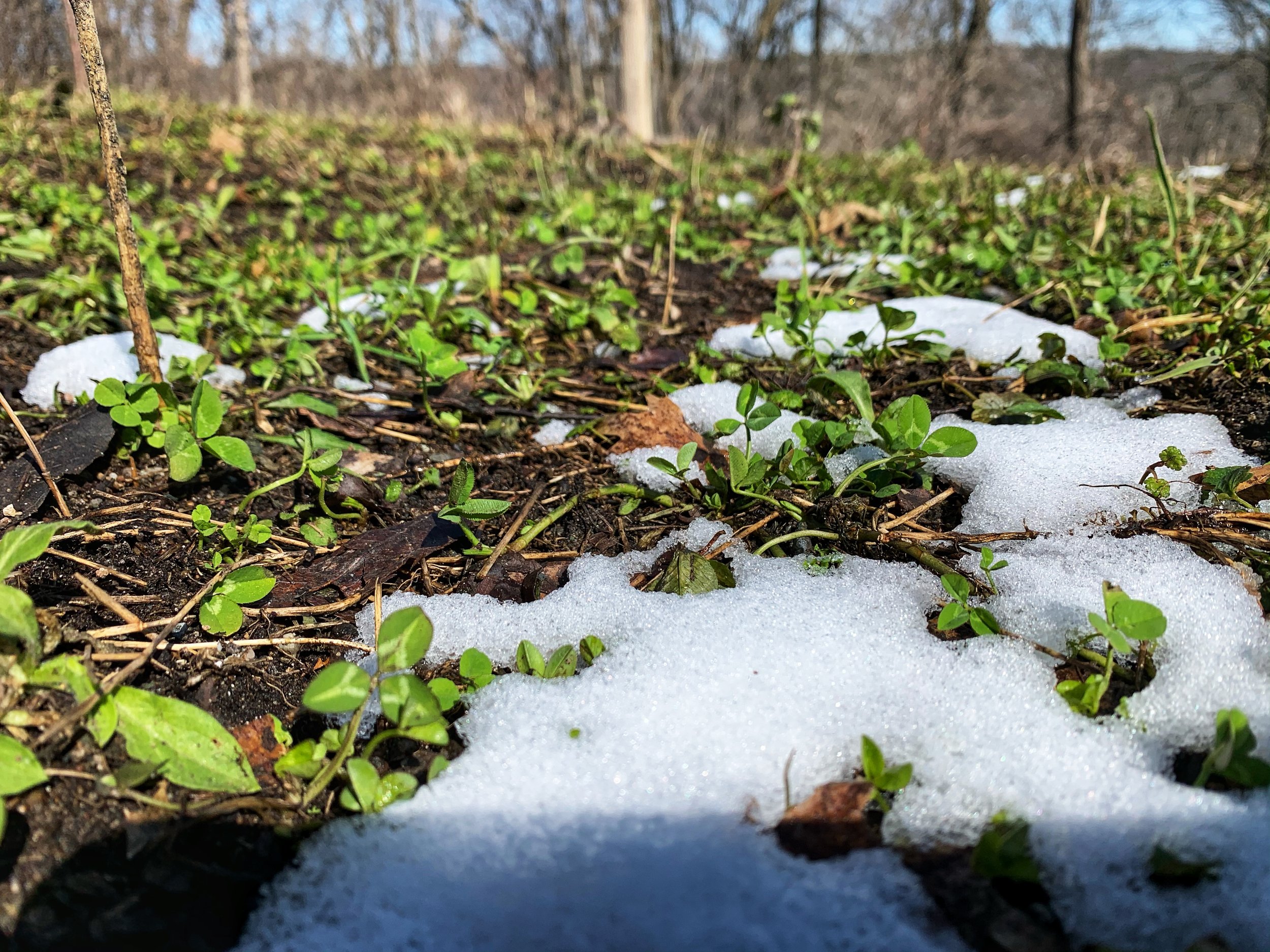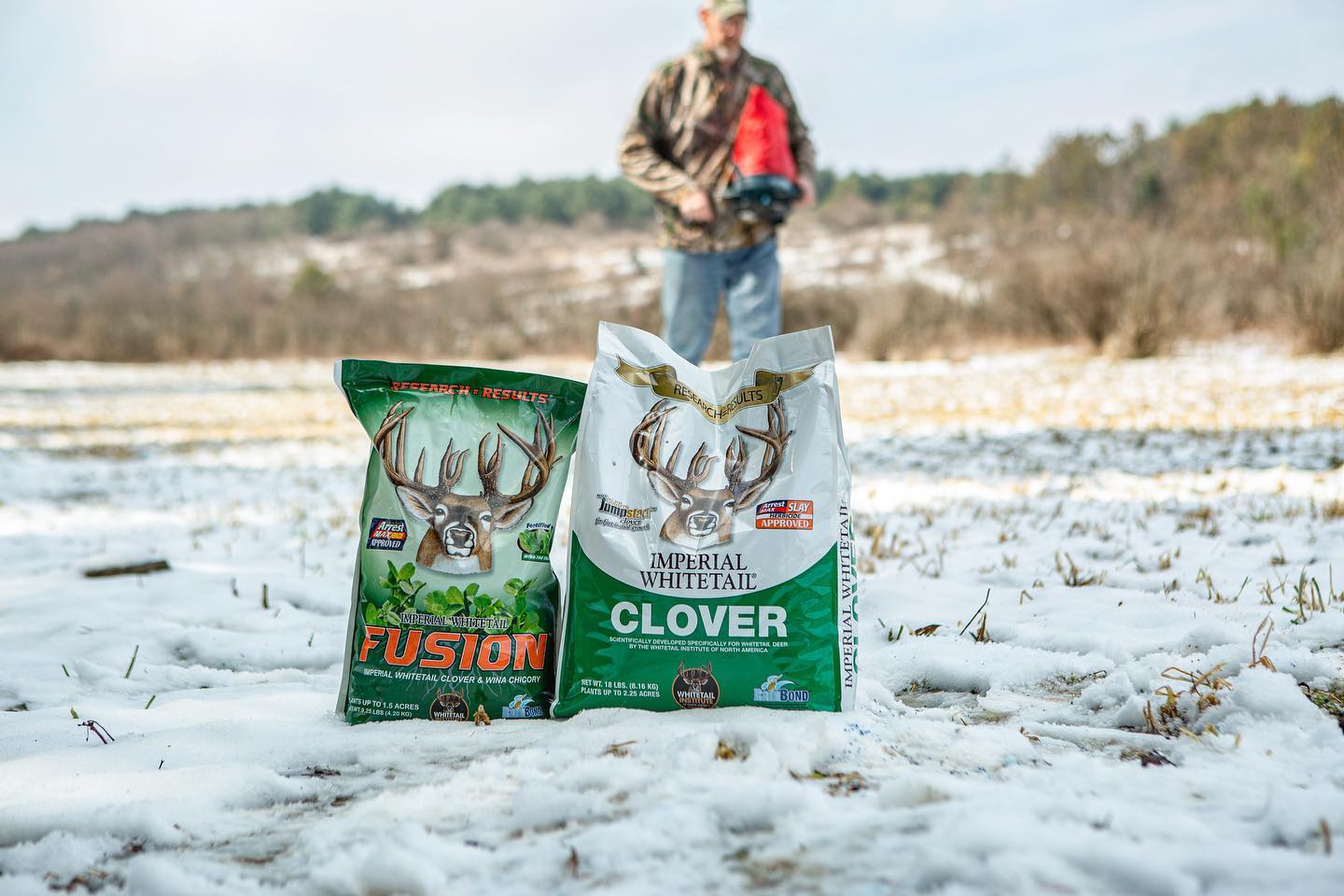Frost Seeding Time is Here
By: John Cristinziani

The end of Winter is the optimal time to rejuvenate your perennial plots of clover and chicory, or a combination of these plants by Frost seeding. If you have never tried your hand at frost-seeding food plots before then you are in for a treat. The process is easy and effective. It requires minimal equipment as all you need is a handheld broadcast spreader.
Before we begin, let’s cover the fundamentals of why and how to frost seed a food plot. Frost seeding allows you to use the thaw, freeze, and thaw cycle phenomenon that occurs during late winter and early spring to revitalize your perennial plots. The last few inches of snow still on the ground in mid to late March in most parts of Canada create perfect opportunities for either establishing a new food plot or rejuvenating an existing one. This window may be very short lived as warming temperatures in the spring can climb very quickly and melt all existing snow within a few hours. If you miss this window, then wait for the ground to dry out somewhat to where there are no more visible puddles and then Frost seed at that time ensuring that it’s done before your existing plants begin to grow. Be sure to have your seed ready and in your possession so you have it ready to go for when you need it.
Over the years, I’ve learned that my best results take place when I frost-seed early in the morning, when the ground is still frozen. Because you want to take advantage of the ground’s freezing/thawing action, broadcasting the seed should not be attempted if the ground is slick or partly thawed.
The pickup and settlement of soil as it thaws during the day and then freezes at night at this time of the year act as a disc or drill, seating the small seeds between soil particles. It also happens to establish that seed in a good amount of soil moisture even before the spring rains arrive. Due to this activity, frost seeding is also exceptional for thickening existing food plots as it allows time for the seeds to settle making good soil to seed contact.
By nature, frost seeding is only possible with the smallest of seeds and needs an aggressive variety to beat out the spring weeds once established. With these characteristics considered, frost seeding is ideal for establishing clover and chicory plots. Clover and chicory just so happen to be the small, secluded, kill plot choices. Whitetail Institute’s Fusion blend combines the clover varieties found in the Imperial Whitetail Clover mix along with the chicory varieties found in Imperial Chic-Magnet. The Clovers and Chicory can tolerate shade, they establish quickly and easily, can be grown in most types of soil, is frost and drought tolerant and can take a beating from heavy grazing. More importantly, Imperial Fusion provides high-nutrition and a remarkable 44% protein blend making it the highest in the industry. Imperial Whitetail is hard-coated, so it will rot while on the ground waiting for spring and 10-degree Celsius ground temperatures to arrive before germinating. Needless to mention that this offers a very attractive Perennial food plot. It provides protein in the spring and summer and can provide green forage well into November and in certain years right up into December.
Frost seeding requires little to no equipment, you only need some quality seed and I like to use a strap-on shoulder hand-crank broadcaster. Whitetail Institute has partnered with a reputable brand named Earthway Spreaders. They offer a model that has a high-volume capacity of 25lbs in a nylon zippered bag. This spreader can be used for a variety of tasks such as broadcasting lime, pelletized fertilizer and of course, the seeds. The nylon bag allows the seed to stay dry during an application should the rain start to fall. It also offers a chart at the bottom of the unit showing the different gate openings required for the type of seeds that you are planting.
When using a broadcast type spreader, be sure and walk your plot North to South and then again East to West. This method will help to ensure that you are not missing and spots.
Be sure to have a large 2 Litre Pepsi bottle filled with water and soap to wash the hardware on any broadcast spreader especially when spreading fertilizer. Pelletized fertilizer is very corrosive and will shorten the life of your broadcast spreader dramatically if not well washed immediately after its use.
 It is important to note the correct seeding rates for establishing clover and chicory food plots. Typically, for an existing plot, you want to Frost seed with approximately 50% of what the seed bag suggests. For a new plot, if your budget allows it, you may even want to double the quantity of seed that is suggested. The objective is to help to choke out some of the bad weeds that will soon be coming up in the plot in early spring. It will also help to conserve valuable moisture for the coming drier summer months.
It is important to note the correct seeding rates for establishing clover and chicory food plots. Typically, for an existing plot, you want to Frost seed with approximately 50% of what the seed bag suggests. For a new plot, if your budget allows it, you may even want to double the quantity of seed that is suggested. The objective is to help to choke out some of the bad weeds that will soon be coming up in the plot in early spring. It will also help to conserve valuable moisture for the coming drier summer months.
Another great benefit of frost-seeding is that it allows to have even more young plants in the food plot. Because the nutritional level of younger plants is greater than that of mature plants, the food plot’s overall nutritional level and attraction remains as high as possible throughout the food plot’s life.
